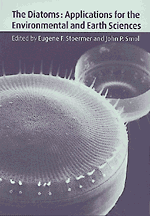Book contents
- Frontmatter
- Contents
- Contributors
- Preface
- Part I Introduction
- Part II Diatoms as indicators of environmental change in flowing waters and lakes
- 2 Assessing environmental conditions in rivers and streams with diatoms
- 3 Diatoms as indicators of hydrologic and climatic change in saline lakes
- 4 Diatoms as mediators of biogeochemical silica depletion in the Laurentian Great Lakes
- 5 Diatoms as indicators of surface water acidity
- 6 Diatoms as indicators of lake eutrophication
- 7 Continental diatoms as indicators of long-term environmental change
- 8 Diatoms as indicators of water level change in freshwater lakes
- Part III Diatoms as indicators in extreme environments
- Part IV Diatoms as indicators in marine and estuarine environments
- Part V Other applications
- Part VI Conclusions
- Glossary, and acronyms
- Index
4 - Diatoms as mediators of biogeochemical silica depletion in the Laurentian Great Lakes
Published online by Cambridge University Press: 16 January 2010
- Frontmatter
- Contents
- Contributors
- Preface
- Part I Introduction
- Part II Diatoms as indicators of environmental change in flowing waters and lakes
- 2 Assessing environmental conditions in rivers and streams with diatoms
- 3 Diatoms as indicators of hydrologic and climatic change in saline lakes
- 4 Diatoms as mediators of biogeochemical silica depletion in the Laurentian Great Lakes
- 5 Diatoms as indicators of surface water acidity
- 6 Diatoms as indicators of lake eutrophication
- 7 Continental diatoms as indicators of long-term environmental change
- 8 Diatoms as indicators of water level change in freshwater lakes
- Part III Diatoms as indicators in extreme environments
- Part IV Diatoms as indicators in marine and estuarine environments
- Part V Other applications
- Part VI Conclusions
- Glossary, and acronyms
- Index
Summary
Introduction
The silica depletion hypothesis (Schelske & Stoermer, 1971, 1972), advanced in the early 1970s, stated that increases in diatom production driven by increases in phosphorus loading increased permanent sedimentation of diatoms, and that the associated progressive utilization of silica in the water column reduced silica reserves and eventually induced epilimnetic silica depletion. This hypothesis, in fact, encompassed several related hypotheses: (i) increased phosphorus loading increases the production of diatoms and other algae with, or without, an obligate requirement for silica, and concomitantly increases silica utilization and production of biogenic silica; (ii) permanent sedimentation of siliceous organisms increases concomitantly with increased production, either reducing or depleting silica reserves in the water mass; (iii) increased production and sedimentation of diatoms, coupled with the imbalance in external loading and supplies of phosphorus and silica relative to the requirements for diatom production, ultimately causes silica-limited diatom growth; and (iv) silica depletion or limitation progressively shifts species composition as assemblages with smaller proportions of diatoms and other siliceous algae and increasing proportions of green and blue-green (cyanobacteria) algae replace assemblages dominated by diatoms. Such changes in composition of phytoplankton affect ecosystem processes by changing trophic structure and trophic efficiency (Rabalais et al., 1996). Subsequent studies refined the hypothesis by finding that epilimnetic silica depletion occurred more rapidly than initially expected (Schelske et al., 1983, Schelske, 1988) and that silica depletion developed not only in the epilimnion but also over the entire water column in the lower Great Lakes (Schelske et al., 1986).
- Type
- Chapter
- Information
- The DiatomsApplications for the Environmental and Earth Sciences, pp. 73 - 84Publisher: Cambridge University PressPrint publication year: 1999
- 16
- Cited by



